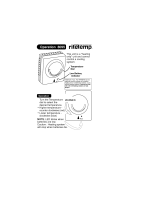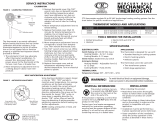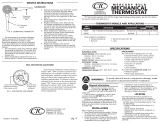
12 69-0333—6
Programming
You can program your thermostat to
automatically lower and raise the temperature
one or more times every 24 hours.
Refer to energy savings chart on the back
cover for typical heating and cooling savings
with your new thermostat.
Before setting your program
Lift thermostat flip-up cover to find the
24-hour program dial. The slots on the program
dial (Fig. 4) are for the program pins that can
be inserted at ten-minute intervals.
Three red and three blue program pins are
included with your thermostat. The red pins
start the high-temperature period; the blue pins
start the low-temperature period. A heating
program is preprogrammed. A red pin is
inserted at 6:00 a.m. for high temperature
(comfort period); a blue pin is inserted at
10:00 p.m. for low temperature (energy saving
period). Two additional sets of pins are located
in the program pin storage area. You can set
up to six temperature changes with the pins
supplied. We recommend at least five hours for
each energy saving period.
To change the pins or add a new energy
saving period—
• To insert a pin, push it straight into the
selected notch on the program dial until it is
completely seated .
• To remove a pin, press against the program
dial and pull the pin straight out. Do
not
attempt to change a pin if it is engaged with
the program index wheel.
• On heating/cooling systems, you must reset
the pins when the seasons change. You will
also probably want to change the lever
positions.
























